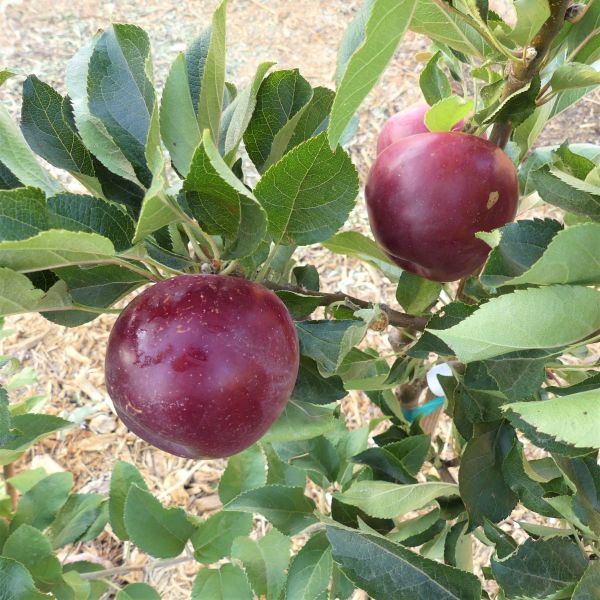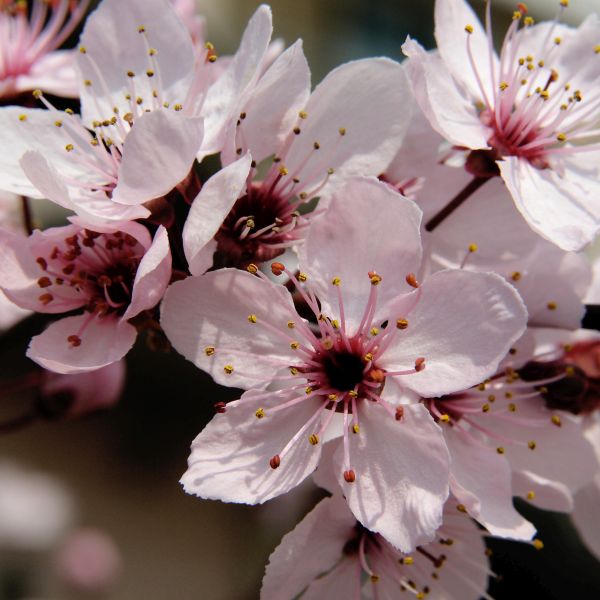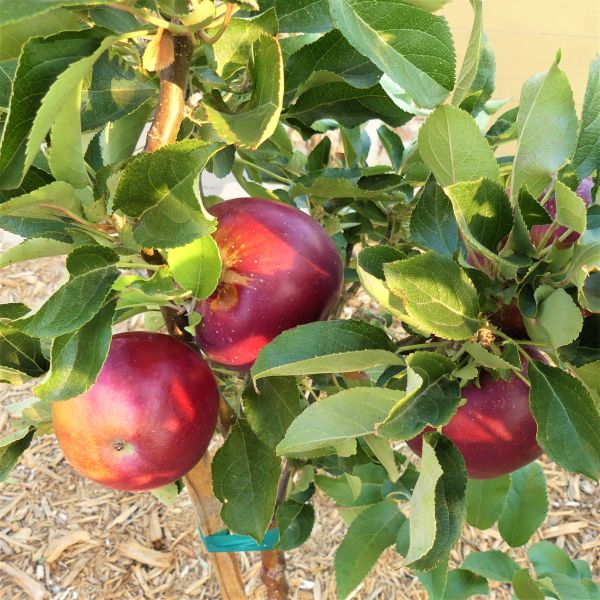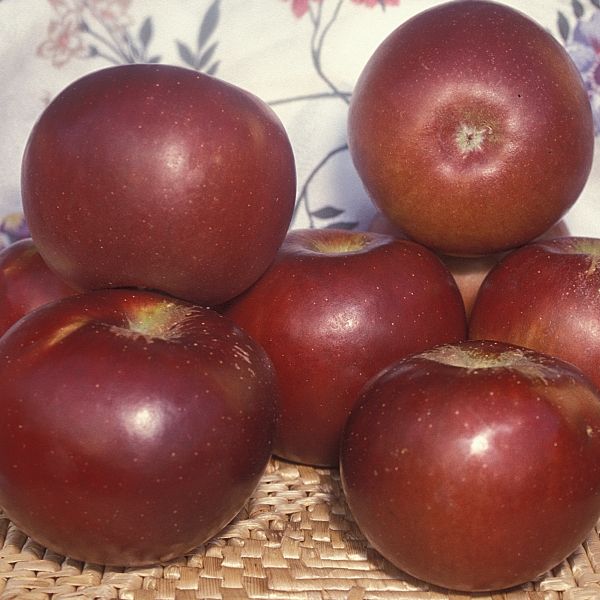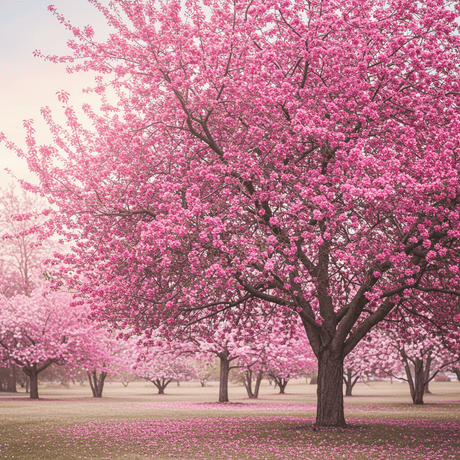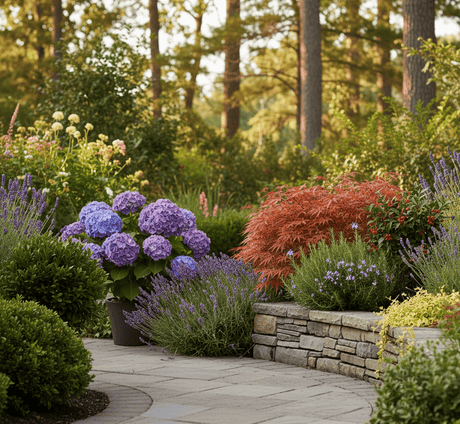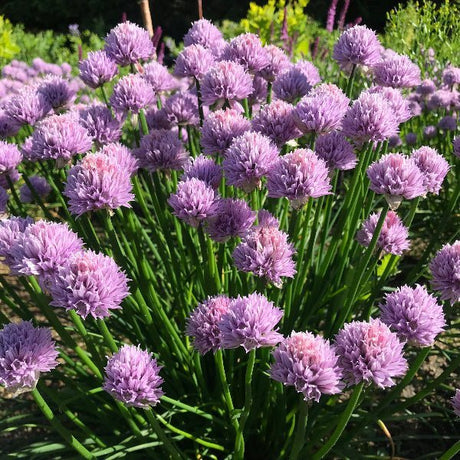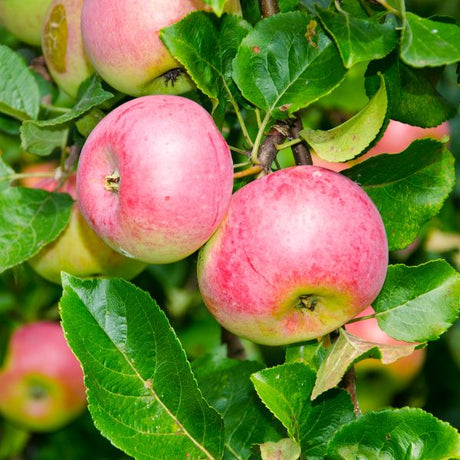Arkansas Black Apple Tree
Malus 'Arkansas Black'
- Stay Protected with Plant Sentry ™
Arkansas Black Apple Tree - #3 Container 3-4 Feet is backordered and will ship as soon as it is back in stock.
Plant Sentry™
Plant Sentry™

Plant Sentry™ Protected
Your order is protected by our compliance system that:
- Prevents restricted plants from shipping to your state
- Ensures plants meet your state's agricultural requirements
- Protects gardens from invasive pests and diseases
Delivery and Shipping
Delivery and Shipping
Delivery and Shipping
Fast, Safe Plant Delivery
Ships in 3-4 business days • Tracking provided • Weather protected
| Under $50 | $9.99 |
| $50 - $99.99 | $14.99 |
| $100 - $149.99 | $16.99 |
| $150 - $198.99 | $24.99 |
| $199+ | FREE |
✓ Zone-specific timing • ✓ Professional packaging • ✓ Health guarantee
Understanding Plant Options
Nature Hills offers plants in two main formats:
- Container Plants: Grown in pots with soil, sized by container volume and plant age
- Bare Root Plants: Dormant plants without soil, sized by height measurements
Container Plant Sizes
Container sizes indicate plant age and growing capacity rather than liquid volume equivalents. Our containers follow industry-standard nursery "trade gallon" specifications, which differ from standard liquid gallon measurements.
Young Plants (6 months to 18 months old)
| Container Size | Actual Volume | Metric Equivalent |
|---|---|---|
| 2" x 2" x 3" | 0.18 - 0.21 dry quarts | 0.20 - 0.23 dry liters |
| 4" Container | 0.31 - 0.87 dry quarts | 0.35 - 0.96 dry liters |
| 4.5" Container | 0.65 dry quarts | 0.72 dry liters |
| 6" Container | 1.4 dry quarts | 1.59 dry liters |
| 1 Quart | 1 dry quart | 1.1 dry liters |
| 5.5" Container | 1.89 dry quarts | 2.08 dry liters |
Established Plants (18 months to 2.5 years old)
| Container Size | Actual Volume | Metric Equivalent |
|---|---|---|
| 2 Quart | 2 dry quarts | 2.2 dry liters |
| #1 Container | 2.26 - 3.73 dry quarts | 2.49 - 4.11 dry liters |
| 5" x 5" x 12" | 3.5 - 4.3 dry quarts | 3.85 - 4.74 dry liters |
Mature Plants (2-4 years old)
| Container Size | Actual Volume | Metric Equivalent |
|---|---|---|
| #2 Container | 1.19 - 1.76 dry gallons | 5.24 - 7.75 dry liters |
| #3 Container | 2.15 - 2.76 dry gallons | 8.14 - 12.16 dry liters |
Large Plants (3-5 years old)
| Container Size | Actual Volume | Metric Equivalent |
|---|---|---|
| #5 Container | 2.92 - 4.62 dry gallons | 12.86 - 20.35 dry liters |
| #6 Container | 5.25 - 6.01 dry gallons | 23.12 - 26.42 dry liters |
| #7 Container | 5.98 - 6.53 dry gallons | 26.34 - 28.76 dry liters |
Bare Root Plants
Bare root plants are sold by height from the root system to the top of the plant. Plants may exceed minimum height requirements.
Common Sizes:
- Trees: 1 foot, 2 feet, 3 feet, 4 feet, 5 feet, 6 feet
- Shrubs & Perennials: 1 foot, 18 inches, 2 feet
Important Notes
Container Volume Specifications
- Trade Gallon Standard: Our containers follow industry-standard "trade gallon" specifications established by the American National Standards Institute (ANSI Z60.1) for nursery stock
- Volume Variations: Actual soil volume may vary due to plant root systems and growing medium settlement
- Age Indicators: Container size primarily indicates plant age and maturity rather than liquid volume equivalents
Growing Conditions
- Plant size can vary based on variety and growing conditions
- Container size helps indicate plant maturity and establishment level
- Larger containers generally mean more established root systems and faster landscape establishment
Seasonal Availability
- Bare root plants are available seasonally when dormant
- Container plants are available throughout the growing season
- Specific varieties may have limited availability in certain sizes
Questions?
For questions about specific plant sizes or availability, please contact our plant experts who can help you choose the right size for your landscape needs.
Plant Highlights
Arkansas Black Apple Tree highlights at a glance!
-
Botanical Name
-
Brand
-
Growing Zones5, 6, 7, 8, 9
-
Growth RateModerate
-
Mature Height
-
Mature Width
-
Leaf Color
-
Flower Color
-
Fall Color
-
Pollinator FriendlyYes
-
Pollinator Required
-
Bloom PeriodEarly Summer, Late Summer
-
Harvest Time
-
FragrantYes
Characteristics
Where To Plant
When To Prune
- Late Winter
Water & Moisture Needs
- Moderate
Sunlight Needs
Soil Needs
- Widely Adaptable
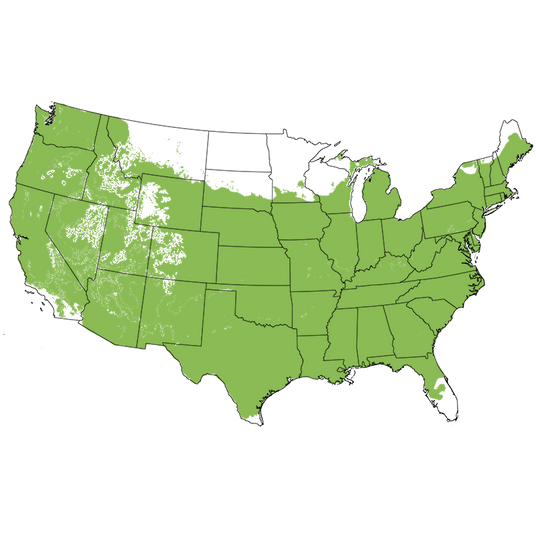
Growing Zones 5-9
Outstanding color and flavor, with unique fruit on a gorgeous ornamental, the Arkansas Black Apple Tree (Malus 'Arkansas Black') will be full of dark red gems, glistening among the fantastic green foliage! This antique variety is a hardy and long-lived tree! The flavor is described as wine and honey, with hints of almonds and a mild vanilla finish, making them amazing dessert apples!
A mid-spring blooming tree and late-maturing apple, each rounded, medium-sized apple is such a deep red with a waxy skin. Appearing almost black, especially when stored, the firm skin shines purple-red in the sunlight and tends to persist on the tree into the fall, making it a favorite of wildlife. The decorative effect of the dark-red apples against the vibrant green of the foliage is not to be missed!
Few can compare to the Arkansas Black! The crisp, whitish-yellow flesh is superb. With a sweet-tart flavor and a firm, yet juicy, complex texture, your Arkansas Black Apple is a treat for all the senses. It develops its best flavor after it has been stored chilled for a couple of months where it will darken and ripen where it sweetens.
Originating in Arkansas in the mid-1800s, these densely textured apples are fantastic for all your desserts and cooking recipes! Taking time to get going, these trees will provide large yields for the long term, so you'll be sure to have plenty for all your recipes, and more for gifts to friends and family!
Your Arkansas Black Apple tree is not only a lovely and resistant tree, but it also produces a substantial harvest of succulent, sweet apples, especially when planted with a suitable pollinator. This Apple is a tetraploid, which is different from many and it will not pollinate other Apple Tree varieties.
Planting and Application:
Oval in shape, the form of this tree is beautiful in the landscape as a standalone specimen and focal point tree! One of these beautiful trees would be an outstanding addition to your yard in any sunny location where you can view it from one of your home's windows…as you won’t want to miss a moment of the bloom or of your tempting harvest's development!
Great privacy when planted in rows and lovely definition for property lines, these are dual-purpose landscaping trees!
Wonderfully proportioned for gardens of all sizes, try your hand at training yours as an Espalier or simply pruning smaller to fit your needs! A smaller tree, your Arkansas Black will grow to about 20 feet in height. Front yard gardening and edible landscaping, this is as hardy a garden plant as it is a healthy snack-producing, beautiful tree!
Imagine a picnic beneath the fragrant pinkish blooms as bees and butterflies hum about the flowers! Plant among your garden beds to provide shade as well as add some cooling shade for your vegetable gardens!
When first harvested, these are hard, firm apples and after hang time or storage, these become amazing fresh-eating apples. Easily kept for months in storage, these are high in Vitamin C and A, fiber, and antioxidants! Pairing well with spices, cranberry, and savory dishes. It is also an excellent apple for cobblers and pies, great for slow cooking and pureeing, soups, and sauces!
The fruit is especially prized for its aromatic nature, it also lends itself well to ciders and applesauce. The firm texture makes these great baked, sautéed and roasted. This apple is a flavorful and fantastic multi-use apple! Arkansas Black has an excellent storage life, affording you many months of enjoyment.
- Gorgeous Deep Dark Red Fruit
- Sharp, Spicy Flavor with High Acid - Tart, Juicy & Crisp Pale Yellow Flesh
- Antique Variety - Ripens Late-September to Mid-October
- High-Quality Eating, Cooking & Great Dessert Apple!
- Fragrant Pinkish-White Blooms
- Pollinators Galore!
- Good Storage Life - Turns Almost Black in Storage
#ProPlantTips for Care:
This Apple variety, with its unique, dark-red color is a favorite among United States growers! Hardy in USDA growing zones 5-9, Arkansas Black is heat and cold-tolerant. This prized Apple variety has very good heat and humidity tolerance and has overall disease resistance.
Fruit trees require full sun for the most blooms and best crops. Any site that receives at least 6 or more hours of direct sunlight a day is perfect. Be sure to provide a location that also has great air circulation. Doing best when planted in any kind of well-drained soil, even tolerating acidic soil and any kind of soil medium as long as it has consistent moisture. Not drought tolerant, your tree will benefit from supplemental watering and a 3-4 inch thick layer of arborist mulch, especially in summer and when planted in warmer growing zones.
It's quite hardy and vigorous, with particular resistance to Cedar Apple Rust. Prune to keep an open canopy and allow air circulation and sunlight into the interior of the tree. Also, prune to thin the early fruit increase the size of each apple, and keep your tree healthy.
Although self-fertile, the Arkansas Black really does best with a pollinator in order to bear lots of fruit. If space is an issue, try planting your two pollinator partner trees together in the same planting site in informal groupings that pollinate each other! Some good pollination partners for this selection include - Centennial Crabapple, Chestnut Crabapple, Dolgo Crabapple, and these Apple varieties: Cortland, Cox's Orange Pippin, Cripps Pink, Cripps Red, Fuji, Gala, Golden Delicious, Granny Smith, Honeycrisp, Idared, Jonathan, McIntosh, SnowSweet, or Wolf River.
- Full Sun
- Well-Drained Enriched Soil
- Appreciates Regular Moisture & Mulched Beds
- Prune Very Early Spring
- Best Harvest With A Pollinator Partner
- ~700-800 Chill Hours
Whether planting just one or an entire orchard, you're sure to enjoy the Arkansas Black Apple! Prized dessert apple and long storage life, this antique variety is a standout, beautiful and healthy tree for your family! Call NatureHills.com today before this gorgeous gem is gone!
Arkansas Black Apple Tree FAQ
When to Plant Arkansas Black Apple Trees
Planting Bareroot trees as soon as you can dig a hole in spring and until hot weather, the earlier the better. Plant container Apple trees throughout the growing season with complete success - that is the benefit of container plants - to extend the planting season. Your County Agricultural Extension Office is a great resource for first and last frost dates in your area.
How to Plant Arkansas Black Apple Trees
Dig a large hole only as deep as needed to accommodate the bareroot or container root ball, and twice as wide. Add Nature Hills Root Booster to speed root establishment. Remove the pot or bag and situate it into the hole so the top of the soil (soil line if bareroot), is level with the new location's soil being careful not to plant too deep. Water in again very well and backfill with the same soil you dug up, tamping down gently to ensure there are no air pockets.
Top off with a 3-4 inch thick layer of Arborist mulch. Consider staking your tree to keep its trunk growing straight for the first year to ensure it stands tall against strong winds and drifting snow.
When to Prune Arkansas Black Apple Trees
Trim off any broken branches from delivery as soon as you take them out of the box. Prune and trim apple trees while dormant, in late winter or early spring, before you see new growth.
How to Prune Arkansas Black Apple Trees
Dormant prune to:
- Remove any double leaders or narrow crotch angles
- Eliminate any crossing branches
- Thin interior branching and leave the fruiting spurs and strong branches in place opening up the canopy
- Branching at least 24-36 inches above the ground
Prune Apple trees in the summer to:
- Control size and shape by reducing the length of longer new growth on vigorous trees
- Remove water sprouts on the main trunk or older branches in the crown
- Remove suckers at the base of the trunk
- Thin fruit during heavy years on established trees
How to Care for Arkansas Black Apple Trees
Growing an apple tree is easy when proper soil, good drainage, attention to moisture, and regular fertility are maintained. Once you've chosen an apple tree that works for your climate, in the size you need for your landscape, and its pollinator (if needed), then you've accomplished half the battle!
- Apple trees do best in full sun and well-drained soil
- Water your Apple trees when they get dry - especially during the fruit production stage, and drought periods to keep them stress-free
- Use arborists' wood chips to mulch over the roots of your apples and have your soil tested to see what your soil may be lacking before adding fertilizers
- Maintenance pruning and shaping
Apple trees will tolerate a wide range of soils, so long as water and nutrients are not limited and the pH level is adequate.
How to Fertilize Arkansas Black Apple Trees
For the first year, water alone is most important. It is always best to get a soil test to see what your soil is lacking before adding more fertilizers. Once established, a fertilizer routine may be beneficial. We do offer some excellent slow-release organic options, applied according to the package directions.
Fruit trees need more phosphate and it's possible to apply too much nitrogen which affects the soil's pH. Test soil acidity or alkalinity using a pH Tester.
Fertilize in spring when you first see new growth emerging.
- Don't overdo it
- Phosphates are your friends
- Pay attention to pH in areas with extremely high or low soil pH
- Follow the directions
Arkansas Black Apple Tree Pollinating Info
Arkansas Black Apple will benefit from being planted with two other varieties for best pollination. Try one of these varieties that will do best for your growing zone.
- Centennial, Dolgo, or Chestnut Crabapple
- Cortland
- Cox's Orange Pippin
- Cripps Pink
- Cripps Red
- Fuji
- Gala
- Golden Delicious
- Granny Smith
- Honeycrisp
- Idared
- Jonathan
- McIntosh
- SnowSweet
- Wolf River
Harvest Times for Arkansas Black Apple Trees
Arkansas Black's are typically ready to harvest in October.
Early-Season? Mid-Season? Late-Season? The terminology can be confusing for new apple tree growers. Weather, climate and your tree determine when it's ripe.
For Apples:
- Early-season is usually June-July
- Mid-season can be August-September
- Late-season can be from late September-November
The growing season consists of spring, summer, and fall, and varies with climate and weather. Areas with longer growing seasons in the warmer hardiness zones can greatly affect the harvest times for each particular apple variety grown in your area.
What Shipping Options Do You Offer?
NatureHills.com works closely with our growers and nursery professionals to ensure we ship when it is most appropriate for your area. Our goal is to deliver the hardiest plants by avoiding extreme high and low temperatures. Check out our shipping schedule for more information and to learn our wills and won'ts when it comes to shipping plants. Find your Arkansas Black Apple Tree for sale here at NatureHills.com!
Popular Apple?s Origins Shrouded in Controversy
The Arkansas Black Apple traces its roots to the apple growing boom in Benton and Washington counties in Arkansas the 1830's to the early 1900's.
The Ben Davis Apple was then the backbone of Arkansas apple growers. Despite the damage done by the Civil War, Arkansas apple orchards continued to grow and by the late 1800's Benton and Washington counties were the largest apple growing regions in the United States.
Unfortunately, shortly after the turn of the century, years of extreme weather conditions began to take their toll. Severe drought and extremes in hot and cold temperatures, as well as battling pests and diseases all took a heavy toll on the growers. By 1930, the apple industry in Arkansas was all but gone.
There were many apple varieties introduced by the Arkansas growers during this time, but none as impacting as the Arkansas Black. Starting out as a regional favorite, by the late 1800's it made up 15% of the apples grown in Benton and Washington County.
Arkansas Black Apples origin is a bit vague, as two possible accounts are cited.
The first is that a popular Apple tree grower and propagator John Braithwaite of Bentonville had discovered the seedling a result of unknown cross. The second account, and not as well documented, was a claim by John Crawford of Washington county. In either case, the report of the discovery is from the mid 1840's. In 1870, Jon Braithwaite was offering the trees for sale and is credited with the introduction.
The exact cross has yet to be identified yet. Most common belief is that it is a seedling of Winesap and an unknown parent. Though often confused with the variety, Arkansas Black Twig, these are not the same. However, the Arkansas Black Twig has also been cited as a possible parent to the Arkansas Black Apple.

